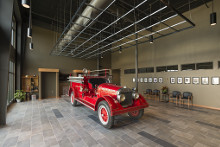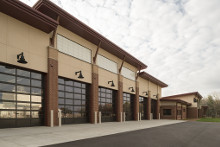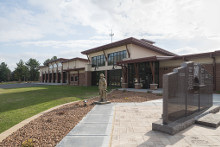
History Room at the Lake Delton Fire/EMS Complex


The Lake Delton Fire/EMS Complex features many of the forward-thinking concepts: private sleeping rooms, fitness center (which is open to other Village departments), integrated training tower and flexible apparatus bay that accommodates traditional response vehicles as well as watercraft and ATVs. The facility also serves as the Emergency Operations Center for the Village.
Are Fire Stations Obsolete?
Traditional fire stations no longer meet the needs of emergency response personnel or the communities they serve for a number of reasons:
- Number of fire calls continues to decline
- Medical calls account for the majority of response types
- Station and staff security and wellness is at the forefront more than ever
- Scope of services offered by fire/EMS agencies will continue to evolve
According to the National Fire Protection Association, 2015 saw roughly 501,000 structure fires in the U.S. For the Country's 1,160,000 career and volunteer firefighters in 2015, that averaged less than 1 structure fire every other year. The trend is not new - 1980 saw 1,065,000 and by 1990, the number fell to 624,000. Predictions say structure fires will continue to decline.
If they aren't fighting building fires, what are Fire Services doing?
- They provide emergency medical services, incident response, urban search and rescue, hazmat response, and homeland security services.
- Nationwide, vehicle fires in 2015 accounted for 204,500 calls while outside/other fires numbered 639,500. These fire types have also decreased significantly over the past 35 years.
- While fire calls have plummeted, other call types have risen dramatically.
- Of the millions of calls fire services respond to today, most are for EMS - around 70 percent is typical.
- Some fire agencies are implementing innovative concepts such as Community Paramedicine, transitional response vehicle, and utilizing a single medic to assess low acuity calls and conduct patient follow-up.
What does this mean for Fire Departments and their facilities?
A New Breed of Station is Here
Many fire and EMS stations built in recent years no longer reflect the traditional big box building with roll-up, overhead doors, barracks-style sleeping quarters, a kitchen and not much more. To remain supportive of the evolving role and scope of services of fire/EMS agencies, their facilities will need to be adaptive.
Tomorrow's facility will be much more than a "fire station." Given the emerging roles of emergency response personnel, new facilities will include many or all of these features:
- Enhanced security – controlled access, security cameras, ballistic protection (particularly in large urban settings), increased storage areas and lockers for individual threat protection equipment.
- Flexible bays that accommodate a greater variety of response vehicles – from Rapid Response Vehicles (RRVs) to paramedicine vans. Forward-thinking ideas such as motorcycle riding paramedics equipped with basic medical kits and heart defibrillators may be helpful for traffic-snarled situations in large, urban areas.
- Dedicated decontamination, transition and clean zones – prevention of exposure to toxins and carcinogens will continue to be a top priority.
- Wellness/Fitness zones – a blend of relaxation areas and fitness spaces will allow staff to decompress, rejuvenate and maintain their health and fitness. Ample natural lighting in these areas has additional benefits.
- Gender separation – private sleeping rooms and bathrooms will continue to grow in popularity as more women and members of the LGBT community join the ranks.
- Durability and flexibility – focus on investing in materials and systems for sustainability and life-cycle costs control will continue to strengthen. Flexible designs will help ensure that the facility does not become outmoded prematurely.
- Need for speed – response time is critical in emergencies and it's the little details of a building that can add to or shave off precious seconds... from the type of bay door and clear paths to apparatus bays to how far personnel must travel within the building.
If your community is considering renovating or building a new fire/EMS station, call or email our municipal facilities experts:

 Meg Roback
Meg Roback Dave Cameron
Dave Cameron